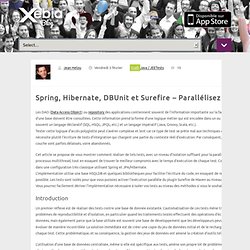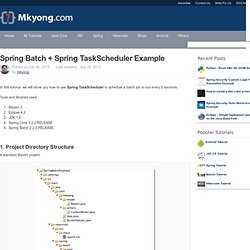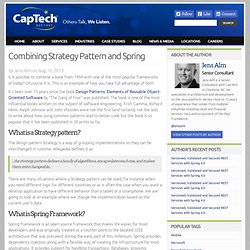

Spring, Hibernate, DBUnit et Surefire – Parallélisez vos tests. Les DAO (Data Access Object) ou repository des applications contiennent souvent de l’information importante sur la façon dont les données d’une base doivent être consultées.

Cette information prend la forme d’une logique métier qui est encodée dans un ou plusieurs langages, souvent un langage déclaratif (SQL, HSQL, JPQL, etc.) et un langage impératif (Java, Groovy, Scala, etc.). Tester cette logique d’accès polyglotte peut s’avérer complexe et lent car ce type de test se prète mal aux techniques classiques de mock et nécessite plutôt l’écriture de tests d’intégration qui chargent une partie du contexte réel d’exécution. Par conséquent, les tests de cette couche sont parfois délaissés, voire abandonnés. Cet article se propose de vous montrer comment réaliser de tels tests, avec un niveau d’isolation suffisant pour la parallélisation dans un processus multithread, tout en essayant de trouver le meilleur compromis avec le temps d’exécution de chaque test.
Introduction Structure du projet. Spring Batch + Spring TaskScheduler example - Nightly. In this tutorial, we will show you how to use Spring TaskScheduler to schedule a batch job to run every 5 seconds.

Tools and libraries used Maven 3Eclipse 4.2JDK 1.6Spring Core 3.2.2.RELEASESpring Batch 2.2.0.RELEASE 1. Project Directory Structure A standard Maven project. 2. Spring 3.0 introduces a TaskScheduler for scheduling tasks. The TaskScheduler will schedule to run below bean. RunScheduler.java P.S JobParamater need to be unique each time a batch job to run, for testing purpose, we just pass in a new Date() everything running the job. 3. This job is just reading a csv file and display the value via a custom writer.
Resources/spring/batch/jobs/job-report.xml <? Sortie de Spring 4.0. Pivotal a annoncé la semaine dernière la sortie de Spring 4.0.

Il s'agit du premier changement de version majeure depuis Spring 3.0, en 2009. Cette nouvelle version amène son lot de nouveautés et trace la voie prise par les technologies Spring au sein de la nouvelle structure Pivotal. Spring 4.0 supporte déjà des nouveautés présentes dans Java 8, notamment les Lambdas. Le framework sera donc déjà prêt pour la sortie de Java 8, prévue pour mars 2014.
Pour ceux qui utilisent déjà Java 8 grâce aux pre-releases, ils peuvent dès maintenant bénéficier de simplifications de syntaxe dans des classes comme le JdbcTemplate. Une des grandes nouveautés est le support proposé pour les WebSocket. Spring 4.0 inclut aussi une version asynchrone du client REST RestTemplate, l'AsyncRestTemplate, afin de pouvoir travailler avec des Futures lors d'accès REST et donc de ne plus bloquer systématiquement le thread appelant.
Combining Strategy Pattern and Spring. Is it possible to combine a book from 1994 with one of the most popular frameworks of today?

Of course it is. This is an example of how you take full advantage of both. It’s been over 15 years since the book Design Patterns: Elements of Reusable Object-Oriented Software by “The Gang of Four” was published. The book is one of the most influential books written on the subject of software engineering. Erich Gamma, Richard Helm, Ralph Johnson and John Vlissides were not the first (and certainly not the last) to write about how using common patterns lead to better code but the book is so popular that it has been published in 38 prints so far. What is a Strategy pattern? The design pattern Strategy is a way of grouping implementations so they can be interchanged in runtime. ... the strategy pattern defines a family of algorithms, encapsulates each one, and makes them interchangeable...
What is Spring Framework? Setting up our Factory Implementing a Strategy Using the Strategy What have we gained?